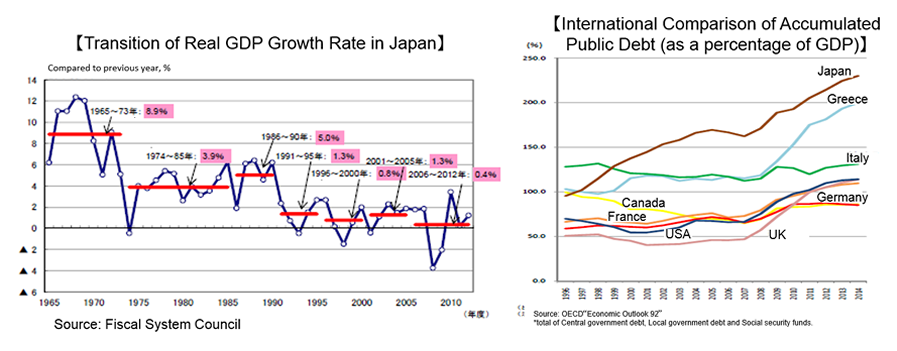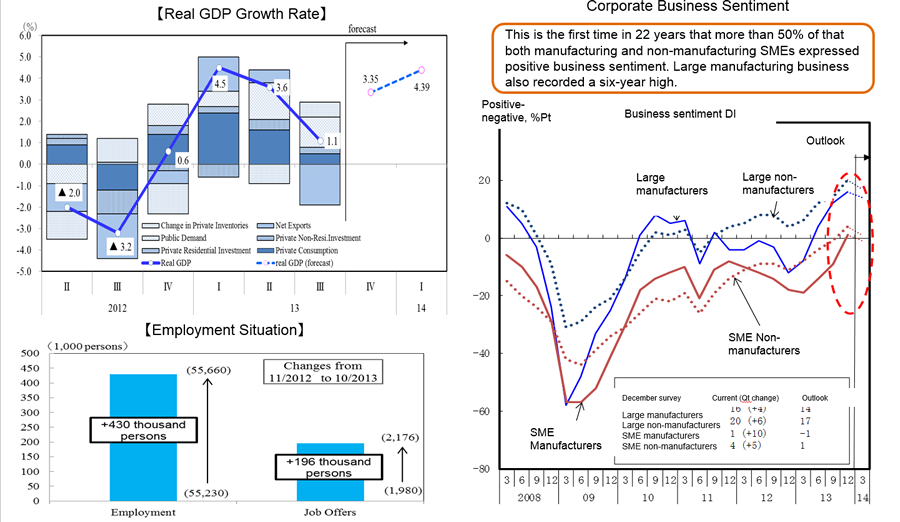- Home >
- Speeches and Policy >
- “Abenomics” is Progressing!
“Abenomics” is Progressing!
2. Achievements of the Abe Administration during its first 12 Months
Fundamental Principles of the Economic Policy
- Japan is seeking to get rid of deflation and, at the same time, to steadily reduce government debt, while we are faced with a unique challenge—a society aging at an unprecedented rate, with a consequent reduction in the nation’s work force.
- To overcome these challenges, Prime Minister Shinzo Abe has taken an initiative of a decisive economic strategy consisting of three pillars, dubbed “the three arrows”. These three arrows consist of aggressive monetary policy, flexible fiscal policy and structural reform of the economy.
- In the 12 month period after the inauguration of the Abe administration, economic growth indicators have shown that the Japanese economy has seen substantial improvement. This recent Japanese economic growth has been one of the strongest in the world.
- On October 1, 2013, Prime Minister Abe decided to increase consumption tax rate from 5% to 8% beginning April 1, 2014. The objective of this increase is to cover social security expenses, which are expected to grow significantly. The Government also formalized 5.5 trillion yen economic stimulus package, which will counter possible negative influence that the increased consumption tax rate in April 2014 may have on the economy. The Government has remained accountable to the public and has consequently retained public support for its decision to increase the consumption tax, which will no doubt cause some degree of financial pain.
The Challenges of Abenomics
- The past 15 years of deflation have not only caused Japan’s economy to stagnate, but also—more fundamentally— have made people lose hope in the future. People feel discouraged to invest, to take on new projects or to engage in new activities. In a vicious circle, this mood has worsened the recessionary trend and has deprived young people of opportunities.
- Due to its long-lasting economic stagnation and large national debt, Japan must find a way to achieve sustainable economic growth and improve its fiscal situation.
- Sustainability is key. Japan must manage its national debt while maintaining its social security system, which is under growing pressure due to the aging population. Robust economic growth is therefore essential to resolve this dilemma.
The First and Second Arrows of Abenomics
- Abenomics started from changing people’s negative mindset, which had been fixed by prolonged deflation and economic stagnation by implementing the first arrow of bold monetary policy and the second arrow of flexible fiscal policy.
The first arrow (bold monetary policy):
Following the bold monetary easing initiatives, the Government is currently closely monitoring market prices and the economy.
- In January 2013, the government and the Bank of Japan (BOJ) released a joint statement introducing a “price stability target” aimed at achieving 2% inflation. In April, the BOJ introduced Quantitative and Qualitative Monetary Easing (QQME).
- The Government views current market prices as being in the process of ending deflation. Bank of Japan Governor Kuroda stated that "if anything were to arise that poses a risk to meeting the price stability target, I will without hesitation make the necessary alterations to our policy."
The second arrow (flexible fiscal policy):
The Government aims to achieve both an end to deflation and fiscal soundness
- In January 2013, the government formulated an economic stimulus package, with an additional budget of 10 trillion yen (an approximately 20 trillion yen in project-size).
- To counter the impact of the April 2014 consumption tax increase (5% to 8%), additional economic stimulus package of 5.5 trillion yen was formulated in December 2013 (around 19 trillion yen in project-size).
- At the same time, the Government will continue to retain its fiscal consolidation target, which includes the halving of the primary deficit by FY2015. The new economic stimulus will also be implemented without issuance of additional Government bonds.
Economic Upturn
- Since the inauguration of the Abe Government, the Japanese economy has been one of the wolrd's best performing economies. Numerous economic indicators have trended positively including consumption, employment stock price and wage indicators.










